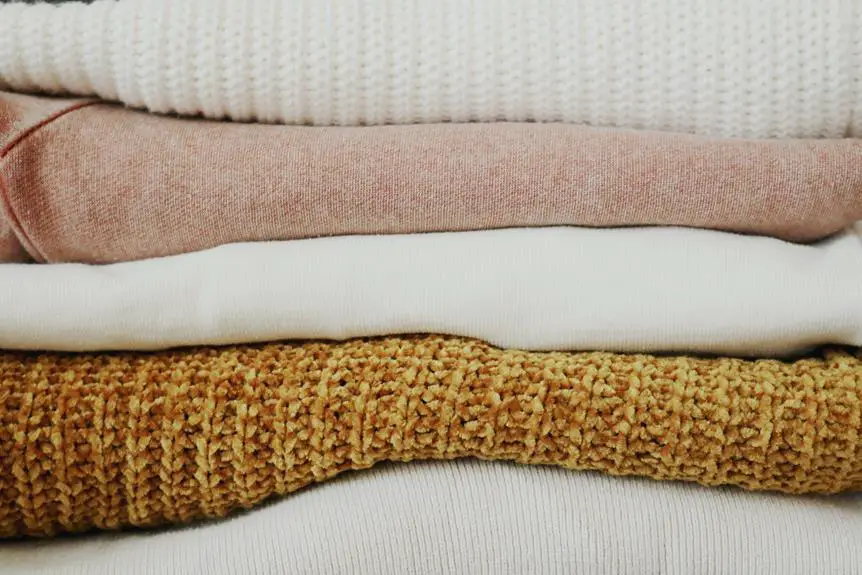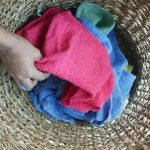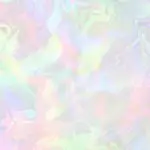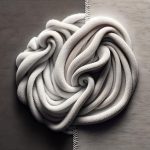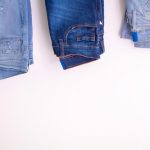Curious about the intricacies of chenille yarn in fabrics? You've stumbled upon the perfect starting point.
Chenille, derived from the French word for 'caterpillar,' isn't just any yarn. It's a velvety, plush material that adds depth and texture to textiles.
As you delve into the world of chenille, you'll uncover its origins, production process, and unique characteristics that set it apart from other yarns.
Stay tuned to master the art of working with chenille yarn and discover its wide-ranging applications in the world of fabrics.
Key Takeaways
- Chenille yarn is a type of yarn that has a velvety texture and adds a luxurious appeal to fabrics.
- It is commonly made from cotton, rayon, or acrylic and is created by wrapping short lengths of yarn around a core.
- Chenille yarn holds color vibrantly, adds depth and richness to textiles, and is ideal for elegant garments.
- It is versatile and can be used for various fabric projects, including upholstery, home decor, and fabric embellishments.
Origins of Chenille Yarn
Tracing the origins of chenille yarn begins with understanding its unique production process. Chenille yarn, with its velvety texture and luxurious appeal, has a rich history dating back to the 18th century. The word 'chenille' itself is French for 'caterpillar,' aptly named for the yarn's fuzzy, caterpillar-like appearance. Originally, chenille yarn was made from silk, giving it a shimmering and soft quality. Over time, the production process evolved, and today, chenille yarn is commonly manufactured using cotton, rayon, or acrylic, offering a wide range of color options and price points.
The properties of chenille yarn have made it a popular choice in the textile industry. Its unique construction involves wrapping short lengths of yarn around a core, creating a pile effect that resembles a caterpillar's fuzzy exterior. This results in a fabric with a soft, plush surface that's both durable and visually appealing. Chenille yarn's versatility allows it to be used for upholstery, bedding, apparel, and decorative items, making it a sought-after material for various applications.
Understanding the history and properties of chenille yarn provides insight into its enduring popularity and widespread use in the textile world.
Characteristics of Chenille Yarn
One key characteristic of chenille yarn is its velvety texture, which adds a luxurious appeal to fabrics. This texture is achieved through the unique construction of chenille yarn, which involves wrapping short lengths of yarn around a core yarn and then securing them in place, creating a soft and fuzzy surface. The resulting fabric properties include a plush, cozy feel that's both visually and tactilely appealing.
Chenille yarn is known for its ability to hold color vibrantly, making it an excellent choice for adding depth and richness to fabrics. Its construction allows for excellent drape, making it ideal for creating elegant, flowing garments and decorative items. Additionally, chenille yarn's natural elasticity provides flexibility and comfort in the finished fabric, making it a popular choice for upholstery and home decor applications.
Understanding the characteristics of chenille yarn is crucial for mastering its use in fabric production. By leveraging its velvety texture, unique yarn construction, and desirable fabric properties, designers and manufacturers can create luxurious, visually striking textiles that elevate the overall aesthetic and comfort of their products.
Production Process of Chenille Yarn
So, how is chenille yarn actually made?
Well, the production process of chenille yarn involves the twisting of short lengths of yarn around a core. This twisting technique creates the soft, fuzzy texture that chenille yarn is known for.
Chenille Yarn Creation
To create chenille yarn, you'll first select a base yarn and then weave it into a fabric. The creation process involves several key steps:
- Base Yarn Selection: Choose a soft and pliable yarn, often cotton or rayon, as the base for the chenille yarn.
- Weaving Technique: Utilize specialized weaving techniques such as the unique 'leno' weave to create the characteristic fuzzy texture of chenille.
- Twisting and Cutting: Twist the woven fabric to create the chenille yarn effect, and then cut the twisted fabric into individual yarn pieces.
These essential steps result in the creation of luxurious and soft chenille yarn, historically prized for its plush texture and versatility in fabric applications.
Yarn Twisting Techniques
Start by selecting a soft and pliable base yarn to weave into fabric, then utilize specialized twisting and cutting techniques to create the distinctive texture of chenille yarn.
Yarn selection is crucial for the production process of chenille yarn. The base yarn should be soft and flexible to ensure the final fabric's comfort and pliability.
Once the base yarn is chosen, it undergoes twisting and cutting to form the characteristic tufted appearance of chenille. The twisting technique involves twisting the yarn together and then cutting the twisted yarn to create the fuzzy pile that's synonymous with chenille. This process requires precision and expertise to achieve the desired texture.
Additionally, the twisting and cutting techniques contribute to the fabric's durability, ensuring that the chenille yarn withstands regular use and maintains its plush texture.
Applications of Chenille Yarn in Fabrics
Chenille yarn has a myriad of applications in fabrics, making it a popular choice for various textile products. Its softness and plushness make it ideal for creating cozy blankets, throws, and upholstery.
Additionally, its versatile nature allows for intricate fabric embellishments, adding texture and visual interest to any design.
Softness and Plushness
You'll find that chenille yarn enhances the softness and plushness of fabrics, creating a luxurious and inviting texture. This luxurious feel makes chenille yarn a popular choice for various fabric applications.
Here are a few reasons why chenille yarn is prized for its softness and plushness:
- Comfort: Chenille yarn creates fabrics that are incredibly soft to the touch, making them ideal for cozy blankets, comfortable upholstery, and warm clothing.
- Luxurious Appearance: Fabrics woven with chenille yarn have a plush, velvety appearance that adds an upscale and inviting feel to any space.
- Enhanced Texture: The use of chenille yarn in fabrics adds depth and dimension, creating a visually appealing and tactile experience.
Chenille yarn's ability to elevate the softness and plushness of fabrics makes it a sought-after choice for those seeking luxurious and comfortable textiles.
Versatile Fabric Embellishment
Enhance your fabric projects with chenille yarn, adding texture, depth, and visual interest to a variety of items. Chenille yarn is incredibly versatile, making it an excellent choice for fabric embellishment. Whether you're working on upholstery, quilting, or clothing, chenille yarn can elevate the overall look and feel of your creations.
Use it to create intricate designs, add dimension to plain fabrics, or embellish borders and trims. The unique construction of chenille yarn allows it to be easily manipulated, making it perfect for intricate detailing or bold, statement pieces. Its softness and plushness make it an ideal choice for adding a touch of luxury to your fabric projects.
Experiment with different colors and textures to achieve the perfect yarn embellishment for your unique creations.
Texture and Visual Interest
To create a visually captivating fabric, consider incorporating chenille yarn to add depth and texture. Chenille yarn's unique construction provides a soft, fuzzy texture that adds visual interest to fabrics.
When using chenille yarn, you can play with different color combinations to create dynamic and eye-catching textures. The yarn's pile-like surface allows for the creation of intricate patterns and designs, adding visual depth to the fabric.
Additionally, combining chenille yarn with other types of yarn can create a multi-textured fabric, adding layers of visual interest. Experimenting with varying yarn weights and textures can also enhance the overall tactile and visual appeal of the fabric, making it a versatile choice for creating visually captivating textiles.
- Play with different color combinations
- Create intricate patterns and designs
- Combine chenille yarn with other types of yarn
Advantages of Using Chenille Yarn
Chenille yarn offers durability and softness, making it ideal for creating luxurious and long-lasting fabrics. One of the major advantages of using chenille yarn is its versatility. It can be used to create a wide range of fabric types, from upholstery and draperies to clothing and bedding.
The durability of chenille yarn is another key benefit. Fabrics made with chenille yarn are known for their strength and ability to withstand wear and tear, making them a practical choice for items that will be frequently used.
Additionally, chenille yarn comes in a vast array of color options, allowing for endless possibilities in design and style. The yarn's unique construction also allows it to hold dyes exceptionally well, resulting in vibrant and long-lasting colors in the final fabric.
Whether you're looking for a soft and cozy throw blanket or an elegant piece of furniture, the advantages of using chenille yarn make it a top choice for creating high-quality, beautiful fabrics.
Care and Maintenance of Chenille Fabrics
Proper care and maintenance of chenille fabrics is essential for preserving their quality and longevity. To ensure your chenille fabrics remain in top condition, follow these key tips:
- Regular Vacuuming: Use a handheld vacuum or a vacuum cleaner with a soft brush attachment to gently remove dust and debris from your chenille upholstery and drapes. This helps prevent dirt from embedding into the fabric and maintains its plush appearance.
- Prompt Stain Removal: Act quickly when spills occur to prevent stains from setting into the chenille fabric. Blot the spill with a clean cloth, working from the outer edges toward the center to avoid spreading the stain. Then, follow the manufacturer's recommendations for spot cleaning or seek professional cleaning if needed.
- Gentle Cleaning Methods: When cleaning chenille fabrics, opt for gentle methods to preserve the fabric's durability. Avoid using harsh chemicals or abrasive cleaners that can damage the fibers. Instead, consider using a mild detergent and lukewarm water for cleaning, and always spot test in an inconspicuous area first.
Frequently Asked Questions
Can Chenille Yarn Be Used for Outdoor Fabrics and Furniture?
Chenille yarn is generally not ideal for outdoor fabrics and furniture due to its limited durability and colorfastness in outdoor exposure. Consider using more weather-resistant materials like acrylic or polyester for outdoor use.
Are There Any Environmental Concerns Related to the Production of Chenille Yarn?
When considering chenille yarn, you should be aware of environmental impact and sustainability concerns. The production process can involve chemicals and water usage, which may raise environmental questions. It's important to seek eco-friendly options.
What Are Some Common Misconceptions About Chenille Yarn and Its Properties?
You might think chenille yarn is delicate, but it's actually quite durable. It's a common misconception that it lacks performance, but its unique properties make it a versatile and long-lasting fabric option.
Can Chenille Yarn Be Blended With Other Types of Yarn for Different Effects?
When blending chenille yarn with other types, you can create unique textural and visual effects. Experiment with different yarn combinations to achieve varying levels of softness, sheen, and drape in your fabric, allowing for endless creative possibilities.
Are There Any Specific Care Instructions for Cleaning and Maintaining Chenille Fabric With Embellishments or Embroidery?
To keep your chenille fabric with embellishments or embroidery looking great, follow these cleaning instructions and maintenance tips. Gently vacuum or brush to remove dust and use a mild detergent for spot cleaning. Avoid excess moisture and direct sunlight.
- How Does Ring Spun Cotton Affect Garment Fit and Shape Retention? - August 13, 2024
- What Are the Challenges in Producing Ring Spun Cotton? - August 13, 2024
- Is Ring Spun Cotton Suitable for Plus-Size Clothing? - August 13, 2024

